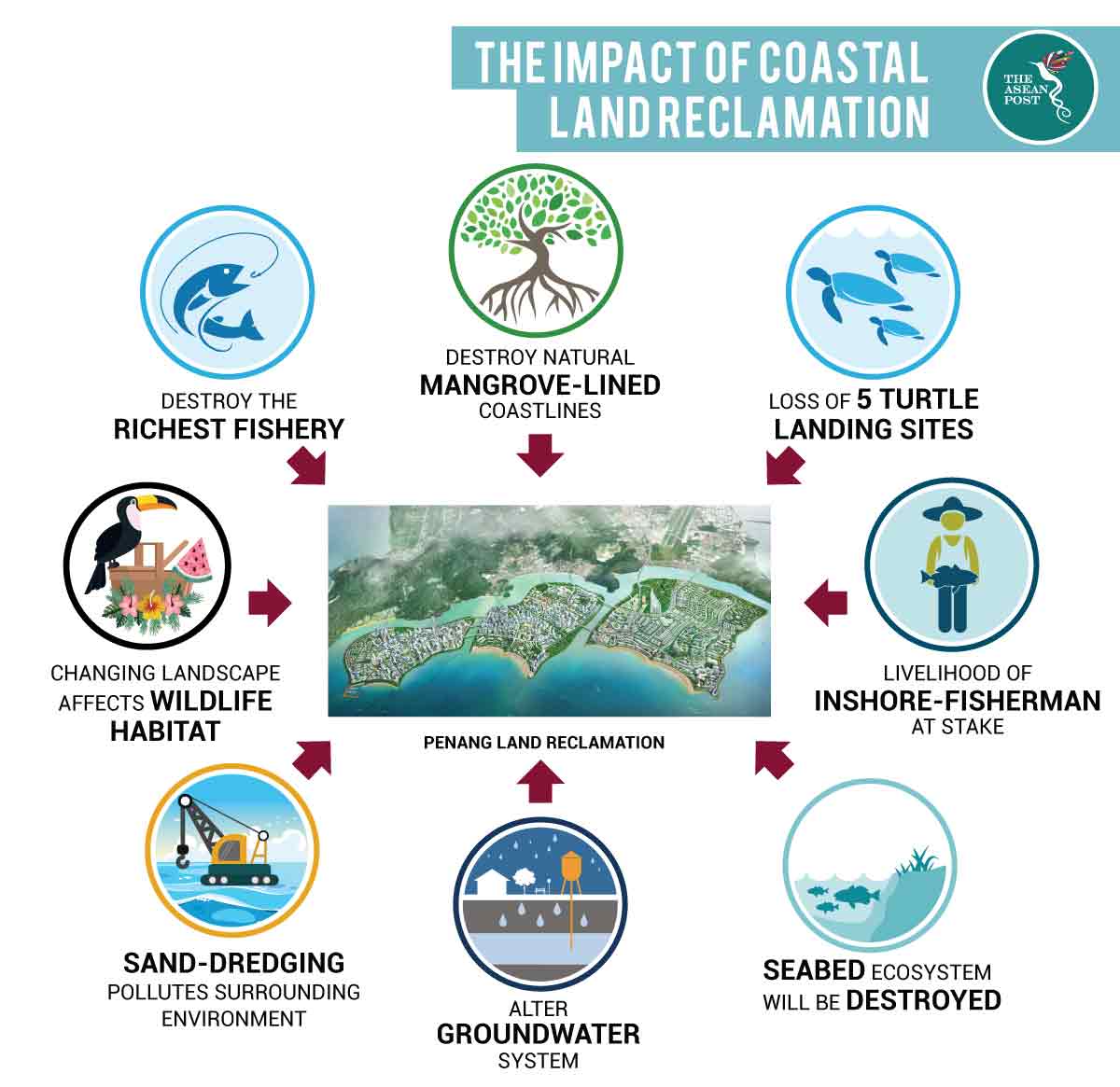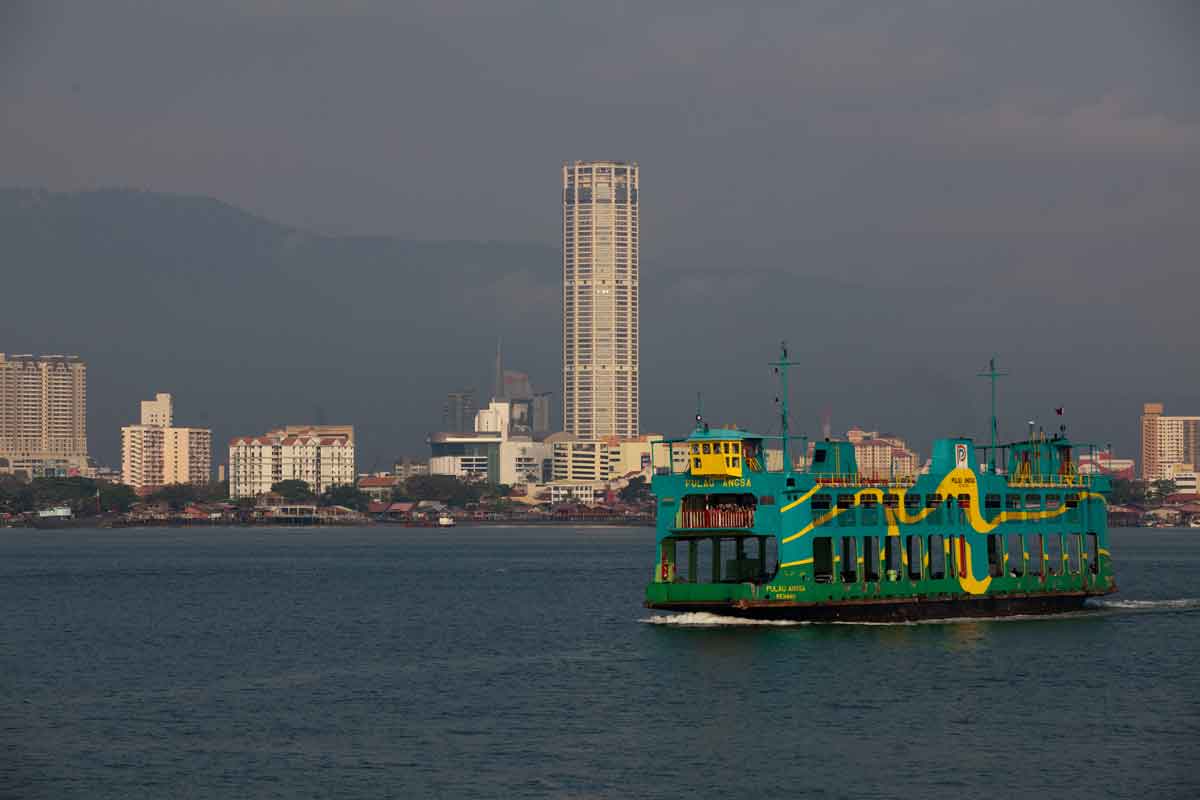The government of Penang, a state in Malaysia, located on the northwest of the country, wants to construct artificial islands on its south bay. The massive development, aptly named the Penang South Reclamation (PSR), is proposed to cover 4,500 acres or seven square miles, which is equivalent in size to the Forest City development in the southern state of Johor, just north of Singapore. A reclaimed land development itself, Forest City aims to hold 700,000 residents on four artificial islands by 2050.
The state of Penang is divided into two parts – an island and a portion of mainland located adjacent to it – with 800,000 and 946,000 inhabitants, respectively. Like many islands, a growing population means the shrinking of available land mass for development, which is one of the reasons given in the reclamation proposal.
Fishermen’s plight
Since the PSR project’s unveiling, members of the public have been vocal in opposing it due to the high risks and negative impact it might have on the surrounding areas. Yet, despite facing resistance, the Penang government continues to push ahead with its plan. The PSR project is expected to generate US$16.9 billion of which US$11.2 billion would be used to fund the Penang Transport Master Plan (PTMP).
The PTMP is a transport project planned to ease traffic congestion on the island and will feature an undersea tunnel linking Penang to the mainland, highways, LRT (light rail transport), monorail and extensive public transport connectivity.
The proposed area for the artificial islands is currently the place where most fishermen around the state coastline live and work. Objections have come from this group of fishermen whose livelihoods and villages are threatened most by this project. Backed by Malaysia’s Fisheries Department and the filing of the initial Environmental Impact Assessment (EIA), the PSR plan was initially rejected in 2018.
Last month, however, Penang’s chief minister Chow Kon Yeow made a misleading statement to suggest that the project was approved by the federal-level National Physical Planning Council (NPPC), after making “significant improvements” to the plan. Although the NPPC has denied approving the project, public interest in the PSR and its negative impact continues to grow.

According to the Penang Forum, formed by a coalition of non-governmental organisations (NGOs) based in Penang, the lack of transparency surrounding the PSR project has led to unsatisfactory explanations and clarifications on the project to the public. The EIA report was made available for public viewing for only a month with limited access to its findings. The Penang Forum has also started a petition, collecting over 39,000 signatures against the project.
Environmental impact
The Consumers’ Association of Penang (CAP) and Sahabat Alam Malaysia (SAM), both NGOs, hold the view that the PSR project is very damaging to Penang and Malaysia. SAM’s publication, ‘Impacts of Coastal Reclamation in Malaysia’, detailed the environmental, and socio-economic impacts of land reclamation projects. In their findings, thousands of hectares of fishing grounds and marine habitat have disappeared due to the trend of land reclamation all across Malaysia.
According to the EIA report, the proposed area for the PSR is the breeding ground for fish, prawns and crabs. In 2017, Penang’s marine aquaculture industry accounted for 55 percent of Malaysia’s US$700 million annual marine harvests, where the area under threat has an estimated wholesale value of fish worth US$10 million. Land reclamation will destroy this rich fishery in Penang, affecting the livelihoods of its fishermen. Chairman of the Fishermen’s Association of Penang Island, Nazri Ahmad, estimates that the reclamation plan puts about 1,800 fishermen at risk.
“For the fishermen, the sea is their life,” he said.
The act of replacing an entire marine habitat with artificial land will always have environmental consequences. Millions of tonnes of marine sand will be mined and rocks quarried to create new land, which will have significant impact to seabed flora and fauna. The deep seabed (benthic zone) and sea meadow habitats will be destroyed and the amount of siltation of the water will increase. Fishermen will be pulling out mud and rocks instead of clams and crabs.
Malaysia, if not the world, stands to lose the vulnerably listed Olive Ridley Turtle. The marine ecosystem surrounding Penang Island is also a playground of the Indo-Pacific Humpback Dolphin and the Indo-Pacific Finless Porpoise. Pollution and contamination will likely disrupt their swimming paths which spread for miles across the oceans.
According to the NPPC, the reclamation project will generate an additional 3.2 million tons of carbon dioxide (CO2) emissions annually adding to ever-rising global temperatures. In the face of climate crisis, the PSR project is environmentally reckless and arrogantly dismissive of all the available research that caution against going ahead with it.
Related articles:
